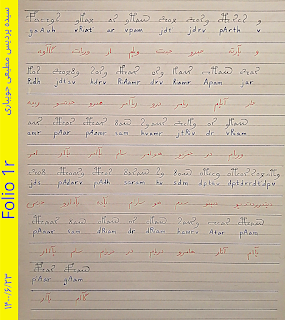Iteration Theory of Voynich Manuscript

Statements: 1. For each paragraph of the Voynich manuscript, there are various repetitive elements in a sequence of words. 2. Each sequence is an island with its own repeating element which is not necessarily the same as the next sequence. Figure 1. (a) Repeating elements are not necessary same as next sequence. (b) The repetitions can be seen in different sequences of words. 3. The structures of sequential repetitions are in three families (See Voynich Sequence: Three Families of Repetitions & Rules of Omission ). 4. There are layers of these repetitions(See Barberry ). 5. The symbols are similar to those in ancient Indian scripts. 6. The coded Persian words can be seen as separated words, relevant to voynich figures. 7. Reading shift will show Persian sentences. 8. There was a mother text, the space of words was removed. The resulting text was divided into small pieces, a sequence of these pieces was selected, and layers of repetitive elements were added. And then the a



